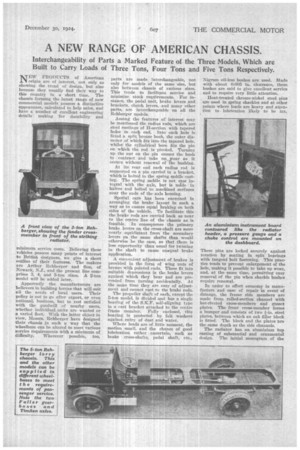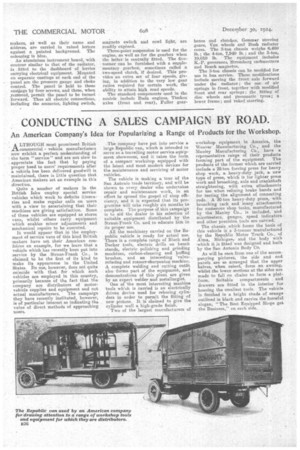A NEW RANGE OF AMERICAN CHASSIS.
Page 19

Page 20

If you've noticed an error in this article please click here to report it so we can fix it.
Interchangeability of Parts a Marked Feature of the Three Models, Which are Built to Carry Loads of Three Tons, Four Tons and Five Tons Respectively.
NEW PRODUCTS of American origin are of interest, not only as showing the trend of design, but also because they usually find their way to this country in a • short tithe. The chassis forming the latest range of new commercial models possess a distinctive appearance, calculated to help sales, and have a number of excellent engineering details making `for durability and
minimum service costs. Believing these vehicles possess many points of interest to British designers, we give a short outline of their features. The makers are Arthur Rehberger and Son, of Newark, NJ., and the present line comprises 3, 4, and 5-ton sizes. A 2-ton model will be added later.
Apparently the manufacturers are believers in building lorries that will suit all the needs of local users. Their policy is not to go after export, or even national, business, but to rest satisfied with the goodwill of nearby users, whether individual, units are wanted or a varied fleet. With the latter object in view, Messrs. Rehberger have designed their chassis in such a way that the wheelbase can be altered to meet various service requirements with a minimum of difficulty. Wherever possible, too, parts are made interchangeable, not only for models of the same size, but also between chassis of various sizes. This tends to facilitate service and minimize stock requirements. For instance, the pedal unit, brake levers and brackets, clutch levers, and many other parts, are interchangeable on all the Rehberger models.
Among the features of interest may be mentioned the radius rods, which are steel castings of H-section with tapered holes in each end. Into each hole is fitted a split bronze bush, the outer diameter of which fits into the tapered hole, whilst the cylindrical bore fits the pin on which the rod is pivoted. Turning up the nut on the pin causes the bush to contract and take np,Fear as it occurs without renewal of the bushing.
At its rear end each radius rod is supported on a pin carried in a bracket, which is bolted to the spring saddle casting. The spring .saddle is not cast integral with the axle, but is made in halves and bolted to machined surfaces near the ends of the axle housing.
Special care has been exercised in arranging the brake layout in such a way as to ensure equal braking on both sides of the vehicle. To facilitate this the brake rods are carried back as near to the centre line of the chassis as is feasible. In consequence the primary brake levers on the cross-shaft are more nearly equidistant from the secondary levers on the stune shafts than would otherwise be the case, so that there is less opportunity than usual for twisting in the shaft to cause unequal brake application.
A convenient adjustment of brakes is provided in the form of wing nuts of bronze with pointed ends. These fit into suitable depressions in the brake levers against which they bear and are prevented from turning accidentally. At the same time they are easy of adjustment and cannot rust to the brake rods.
The propeller shaft of each, except the 5-ton model, is divided and has a single bearing of the S.K.V. self-aligning type in a east bracket attached to the centre frame member. Fully enclosed, this bearing is protected by felt washers against entry of dust and water.
Where loads are of little moment, the motion small, and the chance of good lubrication rather uncertain, such as leake cross-shafts, pedal shaft, etc., Nigrurn oil-less bushes are used. Made with about 0.005 in. clearance, these bushes are said to give excellent service and to require very little attention.
Heat-treated chrome-nickel steel pins are used in spring shackles and at other points where loads are heavy and attention to lubrication likely to be lax.
These pins are locked securely against rotation by seating in split beatings with tangent bolt fastening. This practice tends to prevent enlargement of the hole, making it possible to take up wear, and, at the same time, permitting easy removal of the pin when shackle bushes require renewal.
In order to effect economy in manufacture and ease of repair in event of • damage, the frame side members are made front rolled-section channel with hot-riveted cross-members and gusset plates. The front cross-member forms a bumper and consists of two i-in. steel plates, between which an oak filler block is fitted. The block and the plates are the same depth as the side channels. The radiator has an aluminium top casting of substantial and ornamental design. The initial monogram of the makers, as 'well as their name and address, are carried in raised letters against a painted background. The colouring is blue.
An aluminium instrument board, with contour similar to that of the radiator, ira fitted to the dashboard of lorries carrying electrical equipment. Mounted on separate castings at each end of the panel are the pressure gauge and choke control. The panel is held to these castings by four screws, and these, when yenioved, permit the panel to be turned forward. Thus all electric connections, including the ammeter, lighting switch, magneto switch and cowl light, are readily exposed.
Three-point suspension is used for the engine, as well as for the gearbox when the latter is centrally fitted. The five-tonner can be furnished with a supplementary gearbox, sometimes called . a two-speed clutch, if desired. This provides an extra set of four speeds, giving, in addition to the very low gear ratios required for certain work, the ability to attain high road speeds.
The standard, components used in the models include Buda -engines, Timken
• axles (front and rear), Fuller gear boxes and clutches, Gemmel' steering gears, Van wheels and Bush radiator cores. The 3-ton chassis weighs 6,460 lb.; the 4-ton, 7,940 lb.; and the 5-ton, 10,010 lb. The equipment includes K.-P. governors, 'Stromberg carburetters and Bosch magnetos.
The 3-ton chassis can be modified for use in bus service. These modifications include moving the front axle forward under the radiator; the use of air springs in front, together with modified front and rear springs ; the fitting of disc wheels and iineumatie tyres; a lower frame; and raked steering.






























